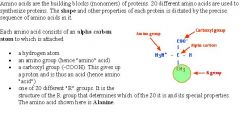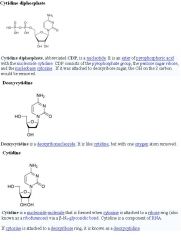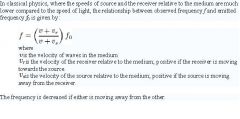![]()
![]()
![]()
Use LEFT and RIGHT arrow keys to navigate between flashcards;
Use UP and DOWN arrow keys to flip the card;
H to show hint;
A reads text to speech;
3 Cards in this Set
- Front
- Back
|
The α carbon of amino acids is the carbon:
(a) to which the R group is attached (b) that is always the chiral carbon of the amino acid (c) that is found at the C terminus of proteins (d) that forms the peptide bond with nitrogen |

The α carbon is the first carbon that attaches to the functional group of the amino acid. Though it is usually also the chiral center of an amino acid, in glycine, it is not. The C terminus is connected to the α carbon; the C terminus carbon also forms the peptide bond with nitrogen since this carbon is a carbonyl.
|
|
|
Cytidine is an example of a
(a) base (b) nucleoside (c) nucleotide (d) deoxynucleotide |

Cytidine is the nucleoside with cytosine as the base. It becomes a nucleotide when phosphates are attached to the ribose. If there are phosphates attached and the sugar is a deoxyribose instead of a ribose, then it is a deoxynucleotide.
|
|
|
Objects A and B move apart from one another. Each object is moving at 10 m/s in the direction opposite to the motion of the other object. Object A of the objects emits a tone of 1000 Hz. What is the frequency of the tone when heard by object B? Assume the speed of sound is 350 m/s.
(a) Greater than 1100 Hz (b) Between 1000 and 1000 Hz (c) Between 900 and 1000 Hz (d) Less than 900 Hz |

Both objects move at 10 m/s away from one another, hence we can consider that one object is stationary while the other is moving at 20 m/s. The equation for calculating the Doppler effect for sound in this case is f = f0(v/v + va) where v is the speed of sound (350 m/s) and va is 20. This makes 1000*(350/370) = 946. Without being able to calculate 35/37, you should be able to tell that 2/37 is less than 1/10 and therefore the frequency change should be less than 1/10 * 1000; hence the frequency must be between 900 and 1000 Hz.
I could also use the original equation f = fo (v+vr/v+vs), but realize that v is the speed of sound (or the speed of sound in the medium) |

